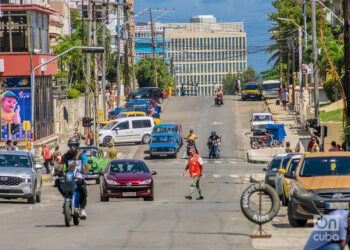Photos: Amauris Betancourt
The purpose was to find out whether or not there were ghosts in the house. People used to say it was haunted, even if they’d never seen it and lived miles away. One person heard about it from another, who heard about it from another, in one of those conversations that turns to apparitions and far-fetched legends. But that’s how legends are passed on, from mouth to mouth. And they go far.
“What makes you think this house is haunted,” I asked.
“They say that things happen there,” a friend answered as we made our way to Rejondones. But he didn’t say what kinds of things people heard.
I assumed that we would hear chains clanking, horrible groans, disturbing footsteps and doors that creaked incessantly. The house was probably inhabited by ghostly creatures that moved from one room to another, defiant and mocking. Everybody knew about it. From east to west, and north to south.
The house is more than twenty kilometers from the city of Holguín, off the road that leads to the cities of Mayarí and Moa. The village is part of Báguanos and is named after a hill.
The late May rains have left the countryside bright green with vegetation. In the morning, the sun casts its rays on the hills, which are covered with shaggy-bark trees and clusters of palms with fronds that wave elegantly in the breeze. Even more beautiful than the royal palms are the Corojos, also known as the Cuban Belly Palm.
When we reach the plain, we find a house. It is not just any house, but one made of cement, chalet-style. The years have not been kind to it, but you would have to go inside to see the cracks left by time on its walls and ceilings, rendering it uninhabitable.
A chuck of the façade has chipped off, revealing pinkish bricks underneath. Its windows have been boarded up, with no sign of shutters. On the porch, plants bloom red and orange flowers in all different types of containers.
A vine winds its way through the various wires that can be seen at the front entrance, but the person who answers the door would not recognize the plant that he waters in te afternoons.
“What a pretty grapevine,” I say to him.
“Oh, yeah,” he answers.
His name is Mauro Ortiz Peña. He is thin, and hasn’t shaved in days. He wears an X Point cap, which bears the slogan in English, “Point X-treme quality drywall screws,” which my photographer translates into Spanish for him. Mauro is not interested in the slogan on his cap. And he is not interested in ghosts, either.
“No way! There aren’t any witches here,” he says, adding with a smile, “We are Christians and we don’t believe in that. Our religion is Pentecostal.”
He says it with confidence, but suddenly, a door opens. A bit startled, we realize that he does not live alone. A little boy comes forward. Two women stand motionless against a wall. Thi is his family. They watch us curiously. We do the same.
They say that a police officer moved into the place and barely lasted a week. He heard sounds, voices, stones being thrown against walls and the roof. Pots would appear full of dirt in the kitchen. That was the story recounted by a passer-by. And we had heard it from somebody long before making this visit.
“It has been abandoned for about twenty years. It was full of weeds. Imagine that, a good house, abandoned,” Mauro comments.
“And why didn’t anyone come to live here?” I inquire.
“Well, it was in danger of collapsing.”
“So why did you all come to live here?”
“We came after Tropical Storm Noel destroyed the home we had built with our own hands. I knew what people said about the place, but I had no choice.”
The current occupant says the house was built by a man from Galicia in the late 1950s. His name was Belisario Ramos, and he lived there with his wife Obdulia until illness forced them to move to Holguín. Then their children came to live there. And then someone else who was not a relative. And so on, until the house was left empty.
Mauro has a family of five. For fifty-eight years he has been a resident of the area, and he is quite familiar with the history of what is now his home.
“Nobody has died here,” he asserts. But then he remembers something: “I brought the whole family to live here, including a daughter who had recently had surgery and who died here within a year.”
My photographer and I exchange glances. The conversation is getting interesting. Mauro speaks in a clear voice.
“The nosy-bodies come here asking questions. When no one was living here, all kinds of tourists would come. We don’t allow that anymore.”
The photographs are part of our report. Mauro places his grandson, who has diabetes mellitus, in the front. Or better said, his house and its shrubbery, cracks and history are placed in the background. It is a history that will not be forgotten. Cars slow down when they pass by, no matter the make or where they’re headed. Someone almost always turns to look. A legend will always be just that: a voice that drifts like a snowflake from top of the hill.






a1_1-75x75.jpg)
.jpg)

